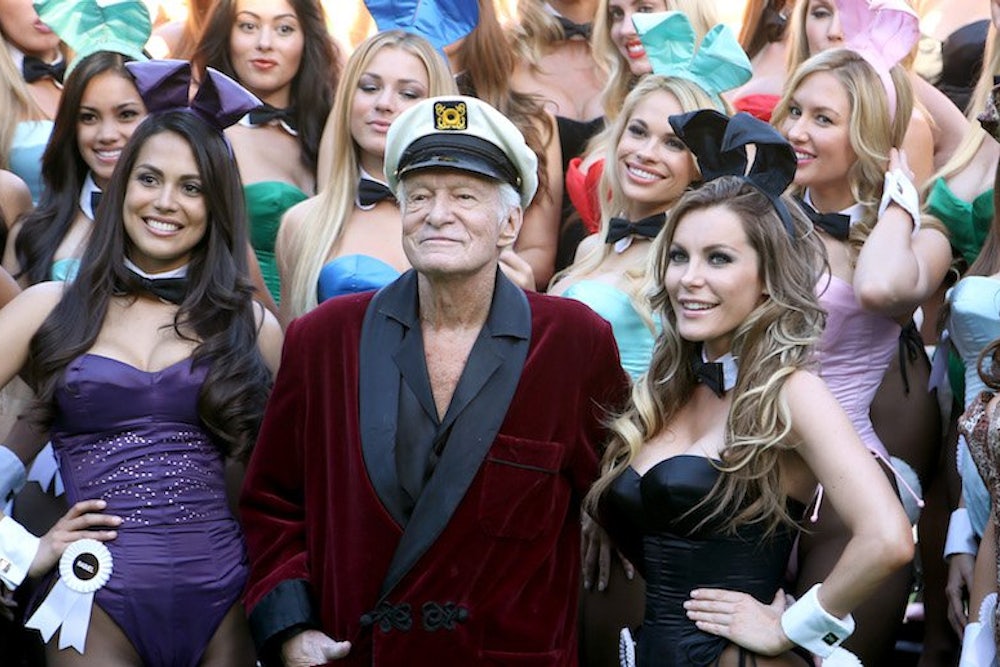It’s almost easier to imagine Egypt without the pyramids than Playboy without nude centerfolds. Yet the iconic men’s magazine is losing the signature photos of buxom women, with their often baffling list of “likes” and “dislikes." This feature has been an inescapable part of the cultural landscape since publisher Hugh Hefner launched Playboy in 1953, so its demise is worth marking—and it's worth investigating the real reason for it.
According to Playboy CEO Scott Flanders, the move is made in the face of a changing cultural landscape which has made pornography much more pervasive and accessible. “You’re now one click away from every sex act imaginable for free,” Flanders told The New York Times. “And so it’s just passé at this juncture.” In the face of our current pornucupia, Playboy will rebrand as a slightly more upscale version of Vice, still testostrone-heavy but not so exclusively catering to heterosexual men, with access to a larger social media audience now that it is Safe For Work and not NSFW. The website Playboy.com has already found that forgoing the print magazine’s nude photos helps it gain a wider reach through social media sites like Facebook, which algorithmically guard against naughty images.
Yet post-porn Playboy is perhaps responding more to economic changes than cultural ones. In truth, Playboy has always sold more than just girlie photos. It’s a lifestyle magazine as much as a porn publication, with the smutty photos offering not just titillation but also serving as part of a larger message of freewheeling consumption. Playboy was born in the early days of the great post-war economic boom and was an essential consumer magazine where millions of upwardly mobile men learned how to spend their rising disposable income.
Playboy and its many imitators were “entrapping young American men in a Never-Never Land, where bachelorhood is a desired state and bikini-clad girls are overdressed, where life is a series of dubious sex thrills, where there’s a foreign sports car in every garage, a hi-fit set in every living room, and ‘Home Sweet Home’ is a penthouse pad,” Marie Torre wrote in Cosmopolitan in 1963. As the historian Elizabeth Fraterrigo noted in her 2009 book Playboy and the Making of the Good Life in Modern America, Playboy fused the girlie magazine format with the consumerist advice found in upscale men’s magazines like Esquire.
“Playboy had lifestyle features that allowed readers to envision an upscale, masculine identity based on tasteful consumption and sexual pleasure,” Fraterrigo wrote. “Each month, ‘modern living’ feature showcased a world of fashionable attire, gourmet food, sports cars, and exotic vacations. Luxurious bachelor pads housed well-stocked liquor cabinets and the latest hi-fi equipment, providing a modish backdrop for collections of abstract art and jazz records. All of these consumptive delights were meant to be enjoyed with a lovely, single, sexually available girl who had no intention of charting a course to the alter.”
For many years, Playboy ran a regular advertising feature called “What Sort of Man Reads Playboy.” The hero of these ads was an aspirational figure the real readers could emulate. Invariably the Playboy Man was a handsome young go-getter, often an executive, who knew how to enjoy the good things and life and impress the ladies. It might be doubted whether the Playboy Man existed in real life or not. In 1955, Hefner admitted the magazine offered an “imaginary escape into the world of wine, women and song.”
Yet even if many aspects of good life the magazine celebrated were fanciful, it reflected a real social reality that during the Golden Age of capitalism from the early 1950s to the early 1970s, many Americans, especially white men, had more money to spend on the consumer items advertised in Playboy. They also had more time. The most fortunate members of the post-war middle class enjoyed well-paying job that were not too taxing, leaving plenty of extra-work hours for vacations—and love affairs.
What happens to a consumer magazine during an age of economic stagnation, where those who do have high-paying jobs have little time to indulge in the gleeful hedonism of the Playboy Man? Playboy had 5.6 million readers in 1975, down to 800,000 today. The shrinkage of readership is surely due not just to competition from the bolder porn found online, but also to the fact that the lifestyle celebrated by the magazine is no longer even a plausible fantasy.
